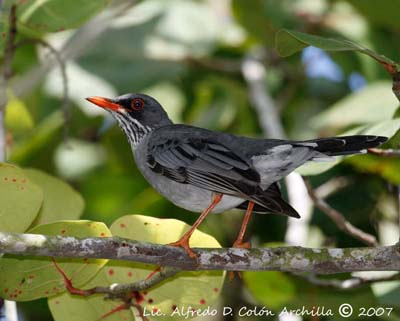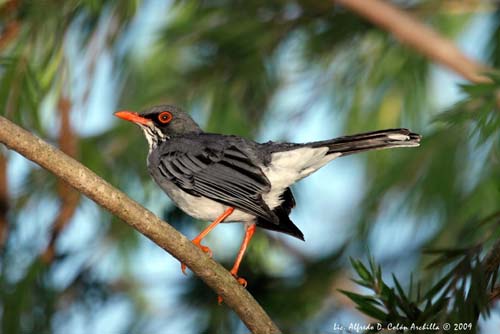
Red-legged Thrush
Turdus plumbeus
Passeriforme Order – Turdidae Family
BIOMETRICS:
Length: 25-28 cm
Weight: 50-82 g
DESCRIPTION:
Red-legged Thrush is a bird of the West Indies.
This thrush is often associated to the American Robin (Turdus migratorius) because they have similar behaviour and they often live near human habitations.
THE PICTURES DISPLAYED IN THIS PAGE SHOW THE RACE FROM HISPANIOLA AND PUERTO RICO - TURDUS PLUMBEUS ARDOSIACEUS.
Read the description in this ID’s card.
PROTECTION / THREATS / STATUS:
Red-legged Thrush is common and widespread.
This species is not threatened at this moment.
Fr: Merle vantard
All : Rotfußdrossel
Esp: Zorzal de Patas Rojas
Ital: Tordo plumbeo
Nd: Roodpootlijster
Photos d’Alfredo Colón
Puerto Rico Wildlife
Texte de Nicole Bouglouan
Sources:
HANDBOOK OF THE BIRDS OF THE WORLD Vol 10 by Josep del Hoyo-Andrew Elliott-David Christie - Lynx Edicions - ISBN: 8487334725
THRUSHES by Peter Clement and Ren Hathway – HELM - ISBN: 0713639407

Adult of the nominate race has slate-grey upperparts and slightly paler grey underparts. Throat is black and chin is white. It has short white malar stripe. Tail is black. Wings are grey and blackish.
On the head, the bill is blackish. Eyes are dark brown with red eye-ring. Legs and feet are red.
Both sexes are similar.
Juvenile has pale yellow bill. Upperparts are slightly mottled blackish, and underparts are buffier with black spots.
We find six subspecies sharing the range and with some differences in colours.
T.p. plumbeus : Bahamas Islands
T.p. rubipres : W and C Cuba and Island of Pines. It has more white at bill base and orange-buff belly. Bill is red.
T.p. schistaceus : E Cuba. It is still whiter at bill base and has red bill too.
T.p. coryi : Caiman Islands. It is smaller with white malar stripe.
T.p. ardosiaceus : Hispaniola and Puerto Rico. Race displayed.
This one has slate-grey upperparts. Wings and tail show black inner webs. Underparts are pale grey, becoming whitish on belly and vent.
White chin and throat are heavily streaked black, ending in white malar stripe. Lores and malar area are black. Bill, eye-ring, legs and feet are coral-red.
T.p. albiventris : Dominica. It is similar to the previous race with shorter wings, longer legs, white belly and yellow bare parts.
These subspecies have the same behaviour.

VOICE: SOUNDS BY XENO-CANTO
Red-legged Thrush’ typical call is a rapid, high-pitched “weecha weecha weecha” or “chu-week chu-week chu-week”. It also utters some weak “slee”. Alarm call is a loud, high-pitched “wiit-wiit”.
The song is melodious but monotonous, including series of phrases such as “chirruit, chirruit, chirruit, eeyu, biyuyu…”
The race “ardosiaceus” utters sharp “pit” between each phrase. It also mimics other birds’ species.
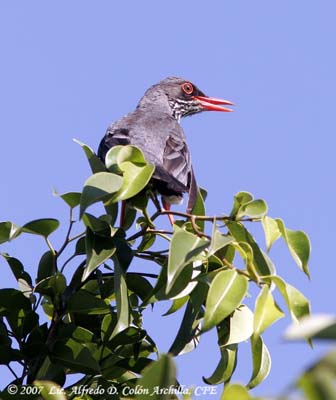
HABITAT:
Red-legged Thrush frequents woodlands and forests, from the edges of the coastal wooded areas and mangroves, to higher forests.
It is often seen in scrub, rainforest’s edges, coffee-plantations, dry thorn-scrub, and dense undergrowth in deciduous woodlands. It also frequents tangled areas in large gardens. It favours the vicinity of water, mainly in drier locations. It may be seen in urban areas.
RANGE:
Red-legged Thrush is found in the Bahamas, Cayman Islands, Cuba, Dominica, the Dominican Republic, Haiti and Puerto Rico.
BEHAVIOUR:
Red-legged Thrush is often seen alone or in pairs, foraging in low vegetation or on the ground within the forest in the early morning.
This species feeds mainly on invertebrates, small vertebrates, fruits and berries. It searches under the leaves, turning over the leaf-litter for invertebrates.
On the ground, the Red-legged Thrush runs or walks with semi-erect tail. It is usually very active when foraging, but it may also remain motionless during long periods.
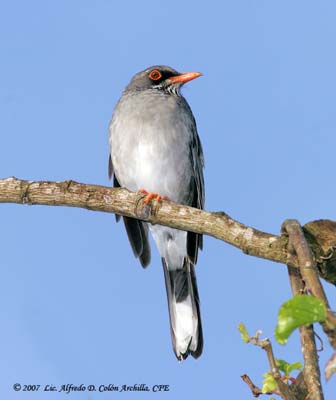
If disturbed, the bird hops away from intruders or flies quickly short distance to the cover.
During the breeding season, Red-legged Thrush becomes noisy. Both mates perform territorial flights together.
Outside the breeding season, the birds sleep at communal roosts.
Red-legged Thrush is sedentary in its range, but we can observe local movements for food, searching for fruiting trees and berries.
FLIGHT:
Red-legged Thrush has an agile flight. The relatively long wings and tail provide manoeuvrability and power. It performs hover-gleaning to take fruits from trees and bushes.
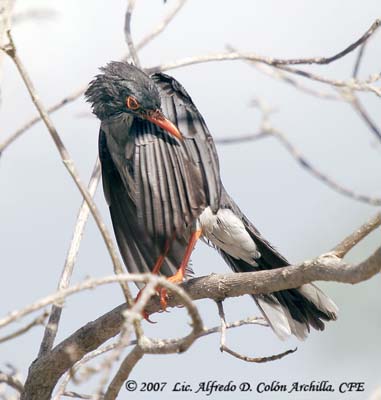
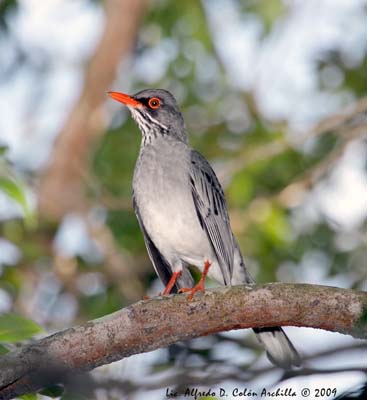
REPRODUCTION:
Breeding season varies according to the location, but the peak occurs between April and July throughout the range.
The nest is usually placed in tree-fork, or palm, on stumps, often on houses in the guttering, at about 8-10 metres above the ground.
It is a bulky nest made with plant materials such as leaves, rootlets, bark, banana fibres and mud. The cup is lined with grass and other materials, horsehair and pine-needles.
Female lays 2-4 pale greenish-white or greenish-blue eggs with reddish-brown markings. Incubation lasts at least 11 days.
The young fledge about 11-12 days after hatching.
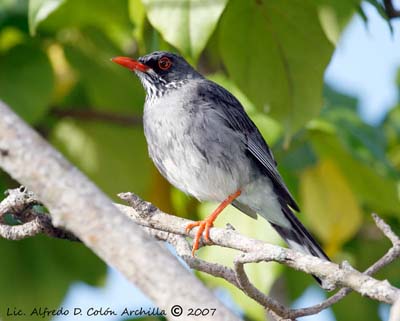
DIET:
Red-legged Thrush feeds on invertebrates such as roaches, snails, worms, spiders, ants, grasshoppers, caterpillars…
It also takes small vertebrates such as snakes, lizards and frogs.
It feeds on fruits of several palm-trees, and also berries and seeds.
